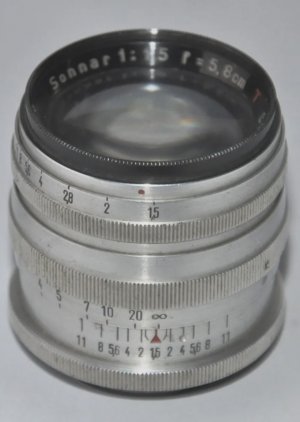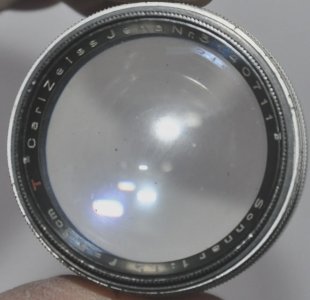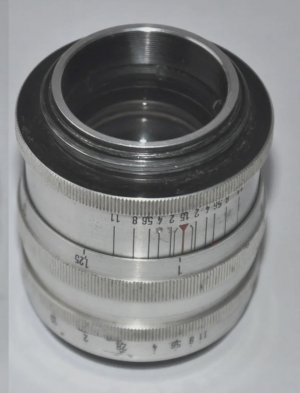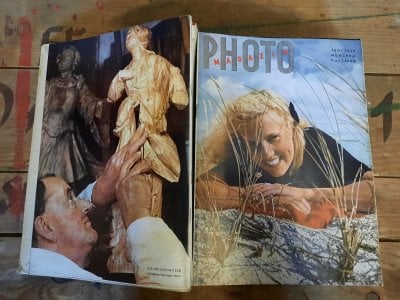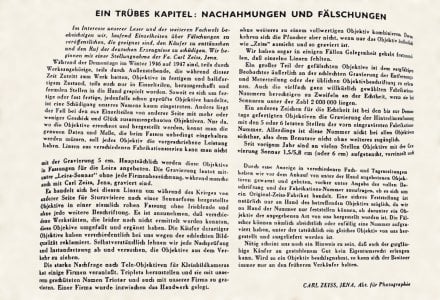TenEleven
Well-known
Yes, that would be my read as well. It most definitely is a conversion.
And the early ones (I would count mine as "early") were clearly meant to be taken for "real" CZJ LTM Sonnars... the intent here is very clear.
In fact there was a German newspaper article how these guys stole lenses from the CZJ factory and remounted them and then got arrested...
Edit: These same guys also remounted Contax 8.5cm lenses into LTM and did a better job than Zeiss. I have one of these. The font is the same. The screws are the same as are the materials and overall fit and finish.
It feels better made and focuses closer and uses a "proper" cam-follower that follows an internal sloped cam akin to the Nikkor 85. This supports the idea that these were not hackers or Amateurs. These guys knew what they were doing.
And the early ones (I would count mine as "early") were clearly meant to be taken for "real" CZJ LTM Sonnars... the intent here is very clear.
In fact there was a German newspaper article how these guys stole lenses from the CZJ factory and remounted them and then got arrested...
Edit: These same guys also remounted Contax 8.5cm lenses into LTM and did a better job than Zeiss. I have one of these. The font is the same. The screws are the same as are the materials and overall fit and finish.
It feels better made and focuses closer and uses a "proper" cam-follower that follows an internal sloped cam akin to the Nikkor 85. This supports the idea that these were not hackers or Amateurs. These guys knew what they were doing.
Last edited:
lukx
Well-known
Would love to see some photos of this 8.5cm Sonnar in LTM mount. I had a 'real' Zeiss one for a brief second but sold it because 1.7m minimum focus was frustratingly far away for portrait purposes. I like to collect a lens here and there, but I want them to be somewhat practical. The mechanical construction of that lens was indeed not ideal.Yes, that would be my read as well. It most definitely is a conversion.
And the early ones (I would count mine as "early") were clearly meant to be taken for "real" CZJ LTM Sonnars... the intent here is very clear.
In fact there was a German newspaper article how these guys stole lenses from the CZJ factory and remounted them and then got arrested...
Edit: These same guys also remounted Contax 8.5cm lenses into LTM and did a better job than Zeiss. I have one of these. The font is the same. The screws are the same as are the materials and overall fit and finish.
It feels better made and focuses closer and uses a "proper" cam-follower that follows an internal sloped cam akin to the Nikkor 85. This supports the idea that these were not hackers or Amateurs. These guys knew what they were doing.
dexdog
Mentor
TenEleven, thanks for the pictures. My lens looks very much like the one you have. I tried to unscrew the optical block from my lens but it was really on tight, and I applied as much torque as I thought safe, not wanting to damage anything. I may have to try again once I work up the courage. I also attempted to take out the rear lens group with a spanner, but it would not budge.
TenEleven
Well-known
I actually owned two 5.8cm Sonnars. The other one I briefly held onto had six spanner slots, like yours. I wanted it as a second lens as I rather like my 5.8cm.TenEleven, thanks for the pictures. My lens looks very much like the one you have. I tried to unscrew the optical block from my lens but it was really on tight, and I applied as much torque as I thought safe, not wanting to damage anything. I may have to try again once I work up the courage. I also attempted to take out the rear lens group with a spanner, but it would not budge.
I like the little bit of extra reach the 8mm afford without the perspective looking too compressed (VS say a 85mm).
However, like you, I found the rear element impossible to remove, which meant I had no way to get to the aperture blades without resorting to violence. Since were getting ridiculously sticky I decided to sell it on at cost. It was not usable (without danger) in this condition, because as you know, if one forces it at this stage you are likely to shear one of the pressed-in pivot pins off.
Sure I will dig up some pictures and post and comment below.Would love to see some photos of this 8.5cm Sonnar in LTM mount. I had a 'real' Zeiss one for a brief second but sold it because 1.7m minimum focus was frustratingly far away for portrait purposes. I like to collect a lens here and there, but I want them to be somewhat practical. The mechanical construction of that lens was indeed not ideal.
TenEleven
Well-known
As promised here is the 8.5cm "fake" (the glass is CZJ and has the appropriate markings on the housings) VS a "real" 8.5cm Sonnar in LTM. The differences in construction are immediately apparent and do not warrant further explanation. I know for sure that this is not a one-off as I have by now seen three examples of this construction in the wild, as well as two black Biotar 5.8cm LTM lenses of nearly identical construction.
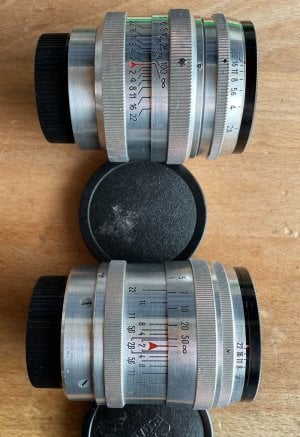
Near focus is a hair under 1.25meters, just like the post-war brethren of this lens. I once had a Arriflex remounted 8.5cm that focused to 0.9m even but found the construction to be on the flimsy side (no internal baffling = reflections, also the near-end stop was literally a 0.1mm thick washer - any amount of force applied past NFD would tear it) so I eventually sold it on.
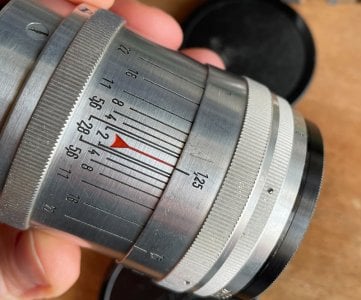
Also of note is the construction. Compare the fonts to the 5.8cm lens. Also all distance and aperture rings are held in by identical set screws like the 5.8cm. Again just like the 5.8cm the distance ring is actually part of the body-work and the set screw actually serves to prevent the optical block from unscrewing. The big screws hold in the cam-follower which we will get to now.
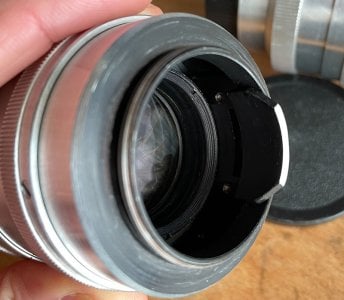
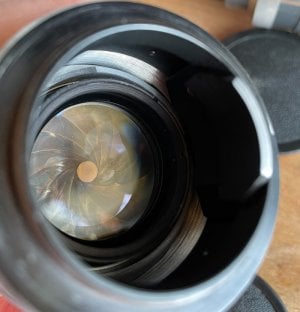
The sloped cam and follower, Nikkor style. You can see that if I took off the delimiter screw I could probably also get 0.9m or so NFD out of this lens since there is quite a bit of slope "left" to use. With such a long and heavy lens this is clearly the way to go and there is no slop in the RF or focus systems whatsoever.
Lastly the aperture blades are made of a similar (shiny, a bit corroded in this example) alloy as the 5.8cm lens. By the way of comparison the blades on a "proper" 8.5cm LTM Sonnar below:
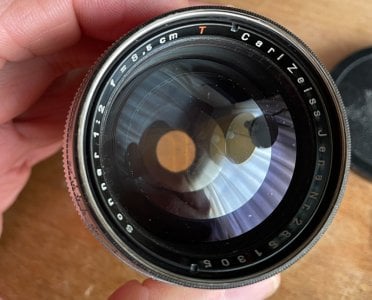

Near focus is a hair under 1.25meters, just like the post-war brethren of this lens. I once had a Arriflex remounted 8.5cm that focused to 0.9m even but found the construction to be on the flimsy side (no internal baffling = reflections, also the near-end stop was literally a 0.1mm thick washer - any amount of force applied past NFD would tear it) so I eventually sold it on.

Also of note is the construction. Compare the fonts to the 5.8cm lens. Also all distance and aperture rings are held in by identical set screws like the 5.8cm. Again just like the 5.8cm the distance ring is actually part of the body-work and the set screw actually serves to prevent the optical block from unscrewing. The big screws hold in the cam-follower which we will get to now.


The sloped cam and follower, Nikkor style. You can see that if I took off the delimiter screw I could probably also get 0.9m or so NFD out of this lens since there is quite a bit of slope "left" to use. With such a long and heavy lens this is clearly the way to go and there is no slop in the RF or focus systems whatsoever.
Lastly the aperture blades are made of a similar (shiny, a bit corroded in this example) alloy as the 5.8cm lens. By the way of comparison the blades on a "proper" 8.5cm LTM Sonnar below:

Zuiko-logist
Well-known
What a fascinating thread, thanks all for sharing this information and images.
AleG
Member
Hello, I take the opportunity to show a slightly different kind of 58/1.5 Sonnar that I just found. It has “classic” postwar sonnar ltm body and everything looks like that, but see on name ring: Carl Zeiss Jena T Sonnar f5.8cm f1.5 - 314xxxx
I’m not such and expert at all, but it looks genuine. I don’t have the lens (yet) but I can ask for additional pictures if interested.
What do you think? Never seen a copy like that
Best regards
Alessio
I’m not such and expert at all, but it looks genuine. I don’t have the lens (yet) but I can ask for additional pictures if interested.
What do you think? Never seen a copy like that
Best regards
Alessio
Attachments
dexdog
Mentor
My guess is that this is probably what Sonnar Brian calls an 'irregular production' lens. As far as I know, CZJ never offically made any 5.8cm Sonnars, although the company did make some 5.8cm/1.5 Biometars following WW2. The serial number does not show up in Hartmut Thiele's book, but there are a bunch of missing records around this number. The lens barrel resembles the wartime CZJ Sonnars in LTM. The distance scale near the base of your lens mount is not standard wartime Sonnar markings (1.5, 2.8, 5.6, 8, 11, 16, 22), and is also different than the lens that is the subject of this thread, which is marked (1.5, 2, 2.8, 4, 5.6, 8, 11).
I suspect it is a "transition" or "Irregular production" lens made of the 5.8cm F1.5 optics. It looks much better made than many I've seen.Hello, I take the opportunity to show a slightly different kind of 58/1.5 Sonnar that I just found. It has “classic” postwar sonnar ltm body and everything looks like that, but see on name ring: Carl Zeiss Jena T Sonnar f5.8cm f1.5 - 314xxxx
I’m not such and expert at all, but it looks genuine. I don’t have the lens (yet) but I can ask for additional pictures if interested.
What do you think? Never seen a copy like that
Best regards
Alessio
Be sure to post some pictures taken with the lens, and of the lens.
We need a dedicated "Irregular Production" lens thread...
TenEleven
Well-known
Hello Alessio,Hello, I take the opportunity to show a slightly different kind of 58/1.5 Sonnar that I just found. It has “classic” postwar sonnar ltm body and everything looks like that, but see on name ring: Carl Zeiss Jena T Sonnar f5.8cm f1.5 - 314xxxx
I’m not such and expert at all, but it looks genuine. I don’t have the lens (yet) but I can ask for additional pictures if interested.
What do you think? Never seen a copy like that
Best regards
Alessio
I am almost certain that this lens came out of the same factory as my & dexdog and other lenses. As said these lenses were meant to look like "real" Sonnars because the intent was to sell them as such. At some later point I guess they started labelling the focal length correctly because well a 'tog would at least catch on about that past their first roll.
Some similarities that stick out to me immediately are:
- Deep engraving of the name ring in a font that is definetly not CZJs - aka not using their stencils
- The white color of the letters is strangely reflective/silver-ish
- The notation of the distance ring font is again similar to my lens
- The rf driver has a helical which by which the lens (I assume your entire optical block also rotates while focusing) translates 58mm to 51.6mm
- The coating claims to be 'T' but is a period-incorrect simple (and soft! be careful) blueing instead
It simply means a group of people (most likely hungry ex-CZJ engineers) banded together and remounted Zeiss glass into Leica RF housings because Contax production was stopped and they needed something to sell...
In fact Zeiss themselves have come out and said as much.
It should be noticed that in the article posted on their newsletter they are very careful to call the final product "fake" not however the lenses, because they are not. These guys absconded some "rohlinge" (meaning unfinished lenses, optical blocks etc.) and decided to finish them by themselves, which eventually lead to their arrest in the 1950ies.
TenEleven
Well-known
TenEleven
Well-known
It took me quite a bit longer than expected, as the typeface is tiny and the print not very good but here it is. I will have to translate it at a later point because I am out of time now. For now, feel free to put it into an online translator (German > English) to get the gist.
My thoughts and annotations are in square brackets. []
My thoughts and annotations are in square brackets. []
Ein Trübes Kapitel: Nachahmungen und Fälschungen [Anmerkung Manuel: Juni 1949]
Im Interesse unserer Leser und der weiteren Fachwelt beabsichtigen wir, laufend Einzelheiten über Fälschungen zu veröffentlichen, die geneigt sind, den Käufer zu enttäuschen und den Ruf der deutschen Erzeugnisse zu schädigen. Wir beginnen mit einer Stellungnahme der Firma Carl Zeiss, Jena.
Während der Demontage im Winter 1946 auf 1947 sind, teils durch Werksangehörige, teils durch Aussenstehende, die während dieser Zeit Zutritt zum Werk hatten, Objektive im fertigem und halb-fertigem Zustand, teils auch nur in Einzelteilen, herausgeschafft und fremden Stellen in die Hand gespielt worden. Soweit es sich um fertige oder fast fertige, jedenfalls schon geprüfte Objetive handlete ist eine Schädigung unseres Namens kaum einegtreten. Anders liegt der Fall bei den aus Einzelteilen von anderer Seite mit mehr oder minder Geschick und Glück zusammengebastelten Objektiven. Nur da, wo Objektive errechnet und hergestellt werden, kennt man die genauen Daten und Maße, die beim Fassen umgedingt eingehalten wuerden müssen, soll jedes Objektiv die vorgeschriebene Leistung haben. Linsen aus verschiedenen Fabrikationsserien kann man nicht ohne weiteres zu einem vollwertigen Objektiv kombinieren. Darum kehren sich die Pfuscher aber nicht, wenn dur das Objektiv äusserlich wie "Zeiss" aussieht und auch so graviert ist.
Wir haben sogar in einigen Fällen Gelegegenheit gehabt festzustellen das einzelne Linsen fehlten.
Ein großer Teil der gefälschten Objektive ist dem sorgfältigem Beobachter äußerlich an der schlechten Gravierung der Entfernungen und Meterteilung oder der üblichen Objektivbeschriftung zu erkennen. Auch die vielfach ganz willkürlich gewählten Fabrikations-Nummern berechtigen Zweifel an der Echtheit, wenn sie bei Sonnaren unter der Zahl 2 000 000 liegen.
Ein anderes Zeichen für die Echtheit ist bei den bis zur Demontage gefertigten Objektiven die Gravierung der Hinterlinsenfassung mit den 5 oder 6 letzen Stellen der vorn eingravierten Fabrikations Nummer. Allerdings ist diese Nummer nicht bei allen Objekiven sichtbar, also dem Betrachter nicht ohne weiteres zugänglich.
Seit vorigem Jahr [Anmerkung Manuel: 1948] sind an vielen Stellen Objektive mit der Gravierung Sonar 1,5/5.8cm (oder 6 cm) aufgetaucht, vereinzelt auch mit der Gravierung 5 vm. Hauptsächlich werden diese Objektive in Fassungen für die Leica angeboten. Die Gravierung lautet mitunter "Leica-Sonnar" ohne jede Firmenbezeichung, während manche auch mit Carl Zeiss, Jena, graviert sind.
Es handelt sich bei diesen Linsen um während des Krieges von anderer Seite [Anmerkung Manuel: wahrscheinlich CZJ möchte sich von der Kriegsbeteiligung hier distanzieren] für Sturzvisiere nach einer Sonnarform hergestellte Objektive, in einer ziemlich Fohen Fassung ohne Irisblende und ohne jede weitere Beschriftung. Es ist anzunehmen, daß verschiedene Werkstätten, die leider noch nicht ermittelt werden konnten, diese Objektive umgefaßt und ergänzt haben. Die Käufer derartiger Objektive haben verschiedentlich bei uns wegen der schlechten Bildqualität reklamiert. Selbstverständlich lehnen wir jede Nachprüfung und Instandsetzung ab und versuchen die Objektive aus dem Verkehr zu ziehen.
Die starke Nachfrage nach Tele-Objektiven für Kleinbildkameras hat einige Firmen veranlaßt, Triplets herzustellen und sie mit unserem geschützten Namen Triotar und auch mit unser Firma [Anmerking Manuel: Firmennamen sic] zu gravieren. Einer Firma wurde inzwischen das Handwerk gelegt.
Durch eine Anzeige in verschiedenen Fach- und Tageszeitungen haben wir vor dem Ankauf von unter der Hand angebotenen Objektiven gewarnt und gebeten, vorher unter Angabe der vollen Beschriftung und der Fabrikationsnummer anzufragen ob es sich von einem Original-Zeiss-Fakrikat handelt. Eine sichere Feststellung ist natürlich nur an Hand des betreffenden Objektivs möglich, da wir an Hand der Nummer nur feststellen können ob darunter ein Objektiv der angegebenen Art von uns hergestellt worden ist. Die Fälscher können nämlich absichtlich oder zufällig eine Nummer aufgraviert haben, unter der tatsächlich ein gleiches Objektiv von uns hergestellt und ausgeliefert worden ist.
Nötig scheint uns noch ein Hinweis zu sein, daß auch der gutgläubige Käufer an gestohlenem Gut kein Eigentumsrecht erlangen kann. Wird so ein Objetkiv beschlagnahmt, so kann sich der Besizer immer nur an den frühren Verkäufer halten.
CARL ZEISS, JENA, Abt. für Photographie
dexdog
Mentor
TenEleven, I have never seen nor heard of this article before, thanks for posting. Very interesting coming from the CZJ company
TenEleven
Well-known
No problem. By the way the thing your lens most likely needs to have done is to reset the RF cam driver. It's most likely out by one turn. Which is probably also what is stopping the optical part from reaching infinity. I found some (but not all!) repair pictures.TenEleven, I have never seen nor heard of this article before, thanks for posting. Very interesting coming from the CZJ company
Side and top view of RF driver cam.
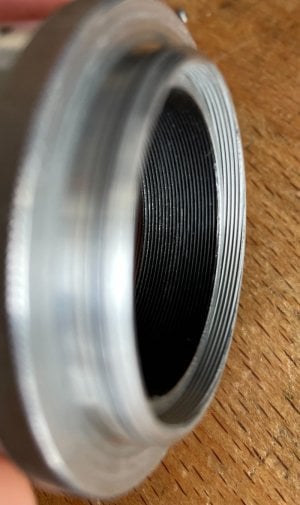
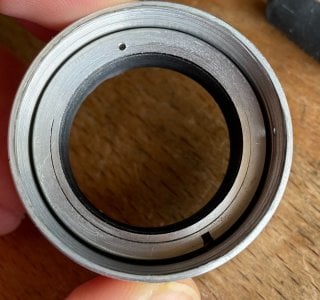
The slot engages via a screw in the focus helical. You can also see the track for the delimiter screw which is the big slot headed screw on the side of the barrel.
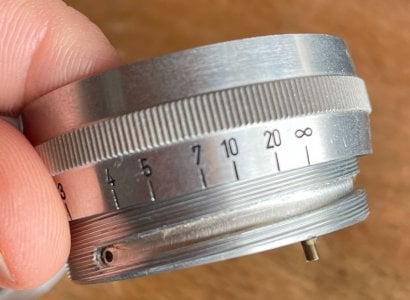
The set screw (bulging out in the middle left quadrant here) through the distance ring holds the distance ring in. In mine however, as you can easily see (by the shredded helical on top) the two rings are fused together and will not come apart. I am lucky that whoever forced them together got them fused at the correct position and that this does not affect the future repairability of the lens. It just makes reassembly a bit fiddly as you now no longer have the luxury of adding the linking-screw (above picture, the brass colored rod) "post fact".
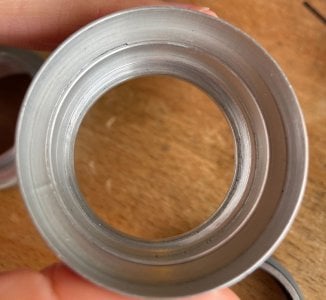
dexdog
Mentor
The two rings on my lens appear to be fused, too. I tried to get them apart, would not move. I may try again, though. Is the brass linking screw moveable or fixed? The one in my lens acts like a loose pin that can be pushed fully into the distance ring, i.e., it will not protrude if the distance ring is turned up-side down. Also, when screwing the distance ring back into the optical block, I found that the threads had 4 starting points, only one of which would allow the lens to focus as close as possible to infinity position (but not enough to allow the lens to work, however). The threads are kinda jacked up on my example, possibly cross-threaded at some point during assembly or re-assembly. When screwing the lens back together it seems that the lens almost catches on another (fifth) starting point that would allow infinity to work.
Last edited:
TenEleven
Well-known
The pin linking the RF-driver and the focus helical together is fixed in my copy. In fact I noticed what could be epoxy around the pins perimeter.The two rings on my lens appear to be fused, too. I tried to get them apart, would not move. I may try again, though. Is the brass linking screw moveable or fixed? The one in my lens acts like a loose pin that can be pushed fully into the distance ring, i.e., it will not protrude if the distance ring is turned up-side down. Also, when screwing the distance ring back into the optical block, I found that the threads had 4 starting points, only one of which would allow the lens to focus as close as possible to infinity position (but not enough to allow the lens to work, however). The threads are kinda jacked up on my example, possibly cross-threaded at some point during assembly or re-assembly. When screwing the lens back together it seems that the lens almost catches on another (fifth) starting point that would allow infinity to work.
So it could be very well possible that yours is what the "original" state looks like. It certainly would make assembly easier.
[Edit: I guess when you point the lens straight down you can potentially run into issues, which is perhaps why they might have changed it.]
Regarding the helical starts - I believe mine had four starts as well. Th RF driver has a couple of starting points also.
However for me there were two plausible helical starts. The first start just reached infinity (turned out to be not correct), the second one overshot infinity by about 40 degrees and turned out to be the correct one.
The limiting screw will not allow the lens to go "past" infinity once in place.
Have you managed to separate the optical block from its helical parent?
I assume there are no shims in there? There weren't in mine causing it to overshoot quite a bit.
I guess CZJ were not that wrong to call the assembly slipshod.
I wonder if these 5.8cm Sonnars are how these guys got their start. Because the 8.5cm while made in the same fashion has much better fit & finish and worked correctly "out of the box" there was no need for me to do anything.
dexdog
Mentor
I have not been able to separate the otpical block from the helical, at least with as much twisting as I thought safe to apply (i have so far resisted using what Big Clive of YouTube would refer to as 'brute force and ignorance').The limiting screw will not allow the lens to go "past" infinity once in place.
Have you managed to separate the optical block from its helical parent?
I assume there are no shims in there? There weren't in mine causing it to overshoot quite a bit.
I guess CZJ were not that wrong to call the assembly slipshod.
I wonder if these 5.8cm Sonnars are how these guys got their start. Because the 8.5cm while made in the same fashion has much better fit & finish and worked correctly "out of the box" there was no need for me to do anything.
I have a couple of 285 series 8.5cm Sonnars that are 47 serial numbers apart that work pretty well on a Canon P, and when mounted on the Sony appear to be fairly accurate when setting the focusing scale at 5 meters and measuring off the same distance from the sensor. Images are nearly in focus at f2, but I do need to nudge the focus ring to about 5.2 meters or so to get crisp focus.
Yeah, I think I will revisit the helicals on my mystery Sonnar.
dexdog
Mentor
dexdog
Mentor
I am guessing that the 5mm long screw that fits through the focus ring into the barrel probably holds the iris mechanism in place. The hole for this screw is visible in the optical block in the first pic in my previous post. Now that I have lens mount apart I will fiddle around with resetting the RF driver cam.
Edit: Nope the iris is held in place by a screw retained by a slot, similar to a LTM Sonnar or a j-3
Edit #2. The5mm screw fits into a helical inside the focusing ring and keeps it from moving
Edit: Nope the iris is held in place by a screw retained by a slot, similar to a LTM Sonnar or a j-3
Edit #2. The5mm screw fits into a helical inside the focusing ring and keeps it from moving
Last edited:
dexdog
Mentor
Share:
-
This site uses cookies to help personalise content, tailor your experience and to keep you logged in if you register.
By continuing to use this site, you are consenting to our use of cookies.


